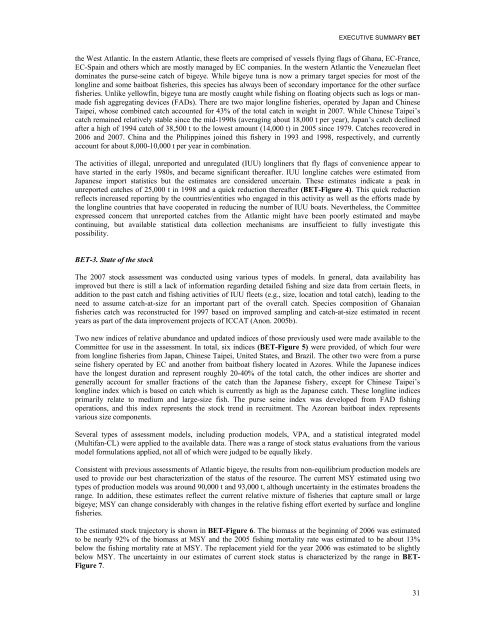REPORT OF THE STANDING COMMITTEE ON RESEARCH ... - Iccat
REPORT OF THE STANDING COMMITTEE ON RESEARCH ... - Iccat
REPORT OF THE STANDING COMMITTEE ON RESEARCH ... - Iccat
Create successful ePaper yourself
Turn your PDF publications into a flip-book with our unique Google optimized e-Paper software.
EXECUTIVE SUMMARY BETthe West Atlantic. In the eastern Atlantic, these fleets are comprised of vessels flying flags of Ghana, EC-France,EC-Spain and others which are mostly managed by EC companies. In the western Atlantic the Venezuelan fleetdominates the purse-seine catch of bigeye. While bigeye tuna is now a primary target species for most of thelongline and some baitboat fisheries, this species has always been of secondary importance for the other surfacefisheries. Unlike yellowfin, bigeye tuna are mostly caught while fishing on floating objects such as logs or manmadefish aggregating devices (FADs). There are two major longline fisheries, operated by Japan and ChineseTaipei, whose combined catch accounted for 43% of the total catch in weight in 2007. While Chinese Taipei’scatch remained relatively stable since the mid-1990s (averaging about 18,000 t per year), Japan’s catch declinedafter a high of 1994 catch of 38,500 t to the lowest amount (14,000 t) in 2005 since 1979. Catches recovered in2006 and 2007. China and the Philippines joined this fishery in 1993 and 1998, respectively, and currentlyaccount for about 8,000-10,000 t per year in combination.The activities of illegal, unreported and unregulated (IUU) longliners that fly flags of convenience appear tohave started in the early 1980s, and became significant thereafter. IUU longline catches were estimated fromJapanese import statistics but the estimates are considered uncertain. These estimates indicate a peak inunreported catches of 25,000 t in 1998 and a quick reduction thereafter (BET-Figure 4). This quick reductionreflects increased reporting by the countries/entities who engaged in this activity as well as the efforts made bythe longline countries that have cooperated in reducing the number of IUU boats. Nevertheless, the Committeeexpressed concern that unreported catches from the Atlantic might have been poorly estimated and maybecontinuing, but available statistical data collection mechanisms are insufficient to fully investigate thispossibility.BET-3. State of the stockThe 2007 stock assessment was conducted using various types of models. In general, data availability hasimproved but there is still a lack of information regarding detailed fishing and size data from certain fleets, inaddition to the past catch and fishing activities of IUU fleets (e.g., size, location and total catch), leading to theneed to assume catch-at-size for an important part of the overall catch. Species composition of Ghanaianfisheries catch was reconstructed for 1997 based on improved sampling and catch-at-size estimated in recentyears as part of the data improvement projects of ICCAT (Anon. 2005b).Two new indices of relative abundance and updated indices of those previously used were made available to theCommittee for use in the assessment. In total, six indices (BET-Figure 5) were provided, of which four werefrom longline fisheries from Japan, Chinese Taipei, United States, and Brazil. The other two were from a purseseine fishery operated by EC and another from baitboat fishery located in Azores. While the Japanese indiceshave the longest duration and represent roughly 20-40% of the total catch, the other indices are shorter andgenerally account for smaller fractions of the catch than the Japanese fishery, except for Chinese Taipei’slongline index which is based on catch which is currently as high as the Japanese catch. These longline indicesprimarily relate to medium and large-size fish. The purse seine index was developed from FAD fishingoperations, and this index represents the stock trend in recruitment. The Azorean baitboat index representsvarious size components.Several types of assessment models, including production models, VPA, and a statistical integrated model(Multifan-CL) were applied to the available data. There was a range of stock status evaluations from the variousmodel formulations applied, not all of which were judged to be equally likely.Consistent with previous assessments of Atlantic bigeye, the results from non-equilibrium production models areused to provide our best characterization of the status of the resource. The current MSY estimated using twotypes of production models was around 90,000 t and 93,000 t, although uncertainty in the estimates broadens therange. In addition, these estimates reflect the current relative mixture of fisheries that capture small or largebigeye; MSY can change considerably with changes in the relative fishing effort exerted by surface and longlinefisheries.The estimated stock trajectory is shown in BET-Figure 6. The biomass at the beginning of 2006 was estimatedto be nearly 92% of the biomass at MSY and the 2005 fishing mortality rate was estimated to be about 13%below the fishing mortality rate at MSY. The replacement yield for the year 2006 was estimated to be slightlybelow MSY. The uncertainty in our estimates of current stock status is characterized by the range in BET-Figure 7.31
















